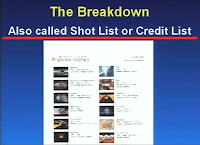Another Wall-E promo video
A bit older but for those who haven't seen it (thanks Brad!)
Hey,
you nailed it! Great! You added all the elements that we talked about. I like the pause that you have after he cuts the wire and how he's happy. I remembered a version where the little hands come right after the cutting, but this works much better. Those little guys really spoil the party.
Like you said, the first part just needs more fleshed out acting in terms of struggling and thinking, but that's all. Show all of this in his face and little hesitation movement in his hands, but don't change anything major in the animation.
About the little hands. Might just be me but I would have them come out like you have it now, THEN do the little turn around (I would actually have them quickly clamp their little fingers twice), THEN go down to the wire and fix it. Let's see what the class thinks about it tonight.
Did you decide on an ending?
I still would have the lamp go on again with very quick blinking and him jumping out of screen, then the bomb explodes with everything in frame turning black and after a flash and that's how you could end your reel, with credits fading into the black screen.
But you're done soon though. I think we found all the major parts (except ending, kinda), so now it's polish time. It's a great clip, don't give up! :)
Cheers
JD
Alright, here some notes, old man first:
He seems pretty good although floaty til 182. Be careful not to have his arms or other parts of his body move like he was underwater or in space (for instance the turn away at around x145). Even someone who just stands there needs to have wait.
Make the inbetween poses as appealing as the main ones. Take x220, that seems a bit too big and unappealing for the old guy. I would keep his poses contained so that there is more contrast between him and the detective, even though the detective is soooo over the top, a contrast is a given :)
Put the detail throughout his whole body, including the fingers. x234 got a very extend thumb on the screen left hand and overall could be a nice pose (what's his attitude right now? Just confused? A bit angry? Probably both, so I would make him tense but not have full on fists for instance). He then gets very spliney/floaty til x321. Get off your chair and move exactly like he does and you feel how awkward it is. Act the old man out, film yourself (or someone else), observe grumpy/confused old people? How do they move? You also keep the hand poses (especially the his right with the extended thumb) throughout this time, give it more complexity.
Common mistake during x278 and x300, the whole upper body/arm/head part moves as one block, which looks very robotic. Same here, act it out, does that feel right? It happens before, from 250 to 270, but there the head is at least independent. Another one at around 380 to 390.
The floaty-ness continues with a very weird and slow body-down from 390 to 410, with his head stuck looking up, then absolut slow motion til x441.
Watch "Geri's Game" for reference of how an animated old man moves (even though your not "supposed" to look at animated stuff for reference), but again, act it out, find a friend who acts it out, ask your grand father, find an old hotel valet guy in the city, youtube, bbc motion gallery, movies, etc. Study reference for movement and timing.
Ok, detective guy.
Zoom out, or lower the camera, or move the detective up a bit (or further away), anything so that his foot is not cut off like that framing wise. It's an awkward start. Just tilt down with your camera, you have enough top space.
First pose on x0 is off balance (he'd fall to the left). So either move his body to the right or have him go immediately into the step towards the right so he's not staying in this pose for long. The pose itself is a bit awkward (mainly his right leg and how crooked the foot is). Stand exactly like him and you'll see what needs to get fixed because you'll feel how awkward that stance is.
Same robot movement feel like the old guy from x0 to x7. The whole upper body moves as one piece. Break it up. Think about what part of the body is leading? What is dragging?
Look at x34, that's also a weird pose. Yes, your character can be weird, but the poses still need to be appealing. The way you can't see his left knee and right knee and how the hand just hangs next to the right leg makes it at very weird silhouette.
[pic is coming, blogger is having problems]
The move towards the old buy is better. Watch out that you don't have things moving at the same time, the same way, like his feet at around x105.
The way he looks up in different spots is good because there are holds, it's not always moving.You might want to move out his right arm at around x154 for a clearer silhouette (so that the hand is not in front of the body). To make it read really well you would have to have the detective more screen right and not in front of the old guy. Imagine you would have just the black bodies in your shot (hit 7 in Maya for that) and look at how the two characters overlap. It would be clearer for the audience to have them separated. You have all that space on your right, there is no need composition wise to have them that closely (easy way to move them apart is to move the old guy to the left, so that you don't have to redo the steps and placement of the detective, there is less to do on the old guy).
Again, check your poses for the rest of the clip. Take x204, the way his hand is rotated back hurts. You also have to get in there and get rid of that default finger position, pose your character all the way at this point.
During the steps back avoid overextension of his legs.
From x238 to x246 for instance it's too much of going from pose A to pose B, everything moves at the same time. Would you move like that? Same with x265 to x273 and the forward bend after that. His swing is too fast during the x300+ part. It's okay in layout and blocking (even in blocking though you should flesh out the timing), but so far into the animation process it looks too cartoony (the rest of the movements seem pretty realistic, so that part stands out as "wrong"). Act it out, time it and change your animation accordingly.
Form x310 to x380 everything is constantly moving, hold a few poses (for instance at around x362 for the "Ha!").
The end is muddy as well. Check x383, he looks like a twisty tie :) That pose needs to be clearer and more appealing (and his foot is sliding), same with x422+.
The quick movements after that also have weird inbetweens. Plot out your arcs, give the animation some rhythm, really work on your poses. During fast action like that you will have to go in there frame by frame. Something like his right foot at x431 should not be in there (you need to rotate the foot down).
The roll is also messy, that needs a lot of clean up, especially foot contact (your feet are sliding all over). And really work on thought out hand/finger poses (get rid of his default hands for your next revision).
Phew, lots to do. :)
Keep going!

 Good resumes are easy to read and have plenty of white space. Simple, clear and concise. (shows sample)
Good resumes are easy to read and have plenty of white space. Simple, clear and concise. (shows sample) Video shows nice DVD wrapper example, matching DVD with DVD label (CONTACT INFO on wrapper, DVD itself, etc.).
Video shows nice DVD wrapper example, matching DVD with DVD label (CONTACT INFO on wrapper, DVD itself, etc.). Movie shows "Breakdown List Sample". (surprised they liked that one, looks like too much work - the second one is cool though with thumbnails for each shot and a little description).
Movie shows "Breakdown List Sample". (surprised they liked that one, looks like too much work - the second one is cool though with thumbnails for each shot and a little description).
Posted by
Jean-Denis Haas
at
12:05 PM
7
comments
![]()
Labels: Examples, Misc, Recommendations, Reference, Resume
 "Get full access to over 1100 video presentations from SIGGRAPH 2003, 2004, 2005 and 2007!"
"Get full access to over 1100 video presentations from SIGGRAPH 2003, 2004, 2005 and 2007!"
The "Sketching Facial Expressions" is an interesting concept. I would love to see a version in the future which would a Jason Schleifer type Greasepencil input within the 3D app, which will allow the user the draw out poses in 2D that affect and pose out the 3D model, or where you look through the render cam and draw poses on top of the cg character and it adjusts the poses accordingly. I would assume that it gets very tricky and distorted because of the 3rd dimension, but it would be cool nonetheless.
Other good clips from the 2007 presentation could be "Resumes and Demo Reels: If yours don't work, neither do you!", "Anyone can make quality animated films!". I'm going to watch a few of these. There's also "Crossing the line: Moving from Film to Game", tons of simulation stuff, character animation, scary sounding stuff like "Data-driven Efficient Production of Cartoon Character Animation", etc. etc.
Good news! Keith Lango is resuming work on his long lost short movie "The Secret Joys of Myopia". I'm all for non-photo real animation!
Holy moly, what a great post by Jeff on his class blog (which you guys should check on a regular basis). It's a link to "Flooby Nooby", which has the following notes:
The full dossier of Eric Goldberg's notes.
250 pages of sketches and writings about
posing, timing, and animation techniques:
Bill Peet's notes on contrast,
persepctive, line density, rhythym,
and composition for any illustrator
and story sketch artist:
Brad Bird's notes on compostion - Part 1:
Brad Bird's notes on compostion - Part 2:
Chris Roman's notes on storyboarding:
The art of thumbnailing for
story artists and key animators:
A newly compiled version of
Walt Stacnfield's Gesture Drawing for Animation:
Effects Design - Full list of notes and
techniques for classical FX animation:

